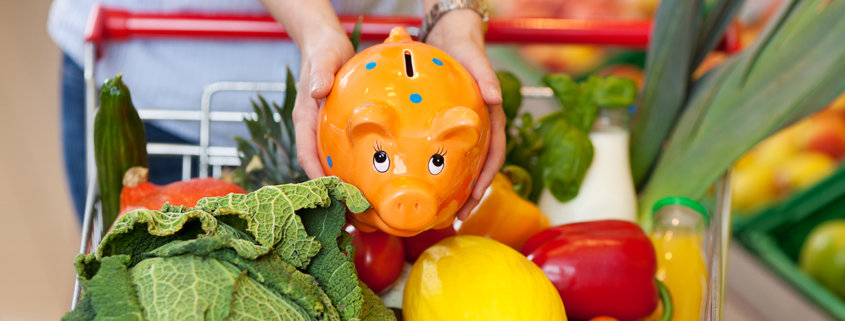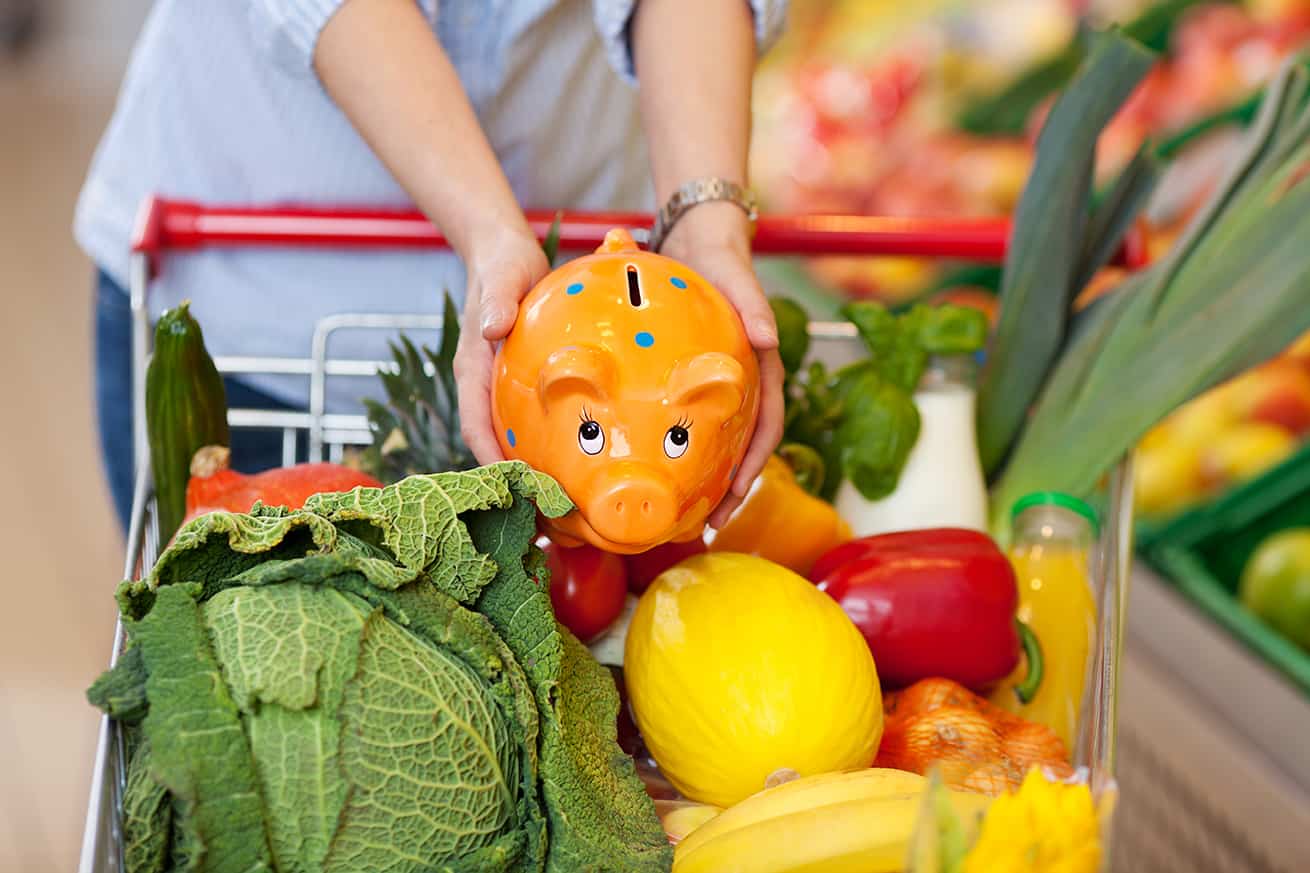15 Insanely Simple Ways to Save Money on Groceries
According to the USDA, a normal American family of 4, is spending on average, $1,333.10 a month on food at home (groceries). Add to that the cost food away from home in restaurants, drive-ins, diners, and dives and we’re talking a lot of money to feed a family, regardless its size
The list is long for reasons why we should get groceries for our meals instead of eating out or ordering in. While it’s typically less expensive than eating out for every meal, grocery shopping isn’t exactly cheap. But it is downright expensive if you don’t have a strategy.
You can do something about this. These tips require effort and perhaps even a change of attitude and food choices, but when combined, they can really add up to make a big difference and keep you on budget.
1. Shake it up, baby!
When buying produce, shake off excess water BEFORE you weigh an item—spinach, lettuce, celery, broccoli, etc. Water weight can add about $1 to your grocery tab PER TRIP—costing you at least $50 a year if you buy groceries each week.
2. Weigh bagged produce
Prebagged potatoes, onions, broccoli, apples, lemons have a fixed price—all those bags are the same price. And they must meet the weight stated in that bag, for example, 5 lbs. potatoes. But rarely does that item weigh exactly the state weight. Take the time to weigh a couple of bags, then choose the one that weighs the most. Eventually, you’ll discover a bag marked 5 lbs that weighs in at 5.5 lbs or more. Prepare to be amazed.
3. Don’t pay full price
Here’s the Golden Rule of Groceries: Eat the sales. Don’t put anything in your basket that is not on sale. If it’s not on sale this week, it will be next or soon enough. If chicken is the loss leader this week, don’t plan meals around beef. And when that happens, try to buy enough chicken to last until the next time it’s on sale. You may need to stop being so brand loyal. Typical supermarkets and grocery stores work on a 12-week rotation. That means everything will be on sale at least once every three months.
Pro Tip
All supermarkets and grocery stores have weekly sales. Consider the sales in several stores to reduce your food by taking full advantage of the greatest number of rock bottom prices.
4. Pass up the grocery cart
Those times you need only to pick up milk, bread or “a couple of items,” pass up the carts (aka trollies for my dear readers in the UK) when all you need are a few items. Surely you can carry the “few things” you need. Or get one of the hand-held baskets. The point here is that you won’t be tempted to add morethan you can carry.
5. Don’t dawdle
This is not the place you want to hang out to soak in all the great sights and smells from the bakery, deli, and rotisserie chickens. If you weren’t hungry when you arrived, you will be soon. Get what you need and get out of there. For every ten minutes you delay, plan on spending about another $35.
6. Don’t deprive yourself
Work some “flex spend” into your budget. We all want to try new things, and in the Candyland-of-choice known as the grocery store, this can lead to expensive last-minute choices. In my experience, the best way to combat this is not to fight it. Allow yourself a little flexibility—say, a five-dollar allowance or a single impulse item each week. That’s the way to avoid the feeling that you’re drowning in deprivation. You’ll be less likely to go overboard.
7. Make a list
This is almost a given, but making a list is the easiest way to see what you need and estimate how much it should cost. Here’s a pretty clever interactive grocery list template.
8. Pay with cash
The best way to stick to the budget is to go in with a plan and pay with cash. Granted, it is becoming more difficult with so many stores preferring that we pay with plastic. Still, if at all possible, cash is going to keep you on track and on budget. When you go to the store with cash in hand, you know exactly how much you can spend. And when you’ve spent what you came with, that’s it. No room for impulsive unplanned purchases.
9. Avoid impulse buys
Another way to prevent impulse buys is to stay out of the store altogether. Grocery pickup services offered by mainstream retailers like Kroger, Target, and Walmart allow you to order your groceries online and then have them brought out to you while you wait in your vehicle.
10. Sell-buy dates
Items like dairy, meat and even some bagged produce come with sell-by dates. Often as that date nears, stores will slap a discounted price tag on them, but not always.
If you find items that are close to their sell-by date that are not discounted, speak up. Ask for a discount. As long as you plan to use these items soon, there’s no problem at all. Sell-buy dates allow for items to be safe and delicious for at least 7 days past the date.
Pro Tip
Last chance produce at a discount may be a great find—but only if you use it immediately. Let those avocados or tomatoes sit on the counter for a few days, and they may be so rotten you have no choice but to throw them in the garbage. Buy only if you will consume it right away.
11. Look high and low
Supermarkets and grocery stores regularly place the higher-priced, brand-name items at eye level. Have you ever noticed that? That’s no coincidence. Not a fluke! It’s on purpose, and you’re being set up to behave impulsively.
Here’s how to beat ’em at their own game: Look high and low. Expect to find generic alternatives, lower-priced brands, and other options. Compare prices. Don’t give in to the manipulation.
12. Shop the cheap stores
Dollar stores offer random non-perishable food items and even fresh produce at hugely discounted prices, so stop there first. You may be able to mark some items off your grocery list. Private label stores like Aldi and Trader Joe’s are notorious for their super lower prices on their food products.
13. Snag manager specials
Most supermarkets’ meat and bakery departments feature “Manager Specials.” Can’t find that in your store? Ask! Depending on the season and that particular store’s inventory, you’ll often find discounts as much as 50% off on anything from meat to bread, poultry, fish, and seafood. When you find these super bargains, buy as much as you can use or freeze, provided that stocking up doesn’t bust the budget.
Pro Tip
Make friends with the meat manager. Ask when they discount items near the sell-by date. Typically it’s about the same time of the day. Now you’ll know when to show up to be first in line for those super savings.
14. Ethnic markets
Even if you’re not into exotic cuisine, Asian, Ethiopian, Latin American food markets are harboring some terrific bargains on items you’re regularly buying at a full price elsewhere. It can’t hurt to check them out! You’re sure to find items like rice, flour, fresh poultry, and produce at regular prices in ethnic markets that beat your supermarket by a mile.
15. Get the app
Your phone is a powerful tool, so download this grocery app. It may be easier than clipping coupons. Ibotta will pay you cash for taking pictures of your grocery store receipts.
Here’s how it works: Before heading to the store, search for items on your grocery shopping list within the Ibotta app. When you get home, snap a photo of your receipt and scan the items’ barcodes, and with that, you’ll get cash back.
Ibotta is free to download HERE. Plus, you’ll get a $5 sign-up bonus after redeeming your first receipt.
Question: Given these tips are just a start, what is your favorite way to save money on the food you eat at home? Please share with us in the comments below?















I just went to the store n while shopping the meat dept I was asking the meat manager n he pointed to me some hamburgers that were marked down from 11 bucks to 5 or 6. So I got two. But I forgot to get from him when they marked down the meat so I will go again n ask the next time I will be there…it is worth it to ask…I just used my food saver to freeze them so I have them for a later use…..It’s amazing that this food saver has saved me soooo much.. 🙂
I make my grocery list and menus with the store ad. I buy what is on sale. I look for coupons and rebates for what I need. If an item is free after coupon I will buy it and donate it or give to a neighbor that is having job problems due to car issues. I use fetch, ibotta, aisle and receipt hog. When I get money back it goes straight into my savings account. I love it. Kroger has cash back too that comes off my next grocery purchase.
1. Menu plan on the weekends, being sure to first use up what you have on hand in fridge & freezer-especially perishables and leftovers
2. We have 2 big meals per week-protein, potato, & side-being sure to prepare extra so theres enough for a leftover meal later in the week. We plan 2 smaller meals per week like soup & sandwich & allow ourselves dessert on those nights. One night is breakfast for dinner (omelettes or pancakes or breakfast type sandwiches) and one night we eat out.
3. Shop the sales & buy multiple of anything thats at a great price.
4. I almost exclusively shop online & use grocery pickup as it keeps me from overspending & I can shop the sales as I prepare my order
5. We regularly have people over for brunch or dinner and we spend less than $400 a month for 2 people